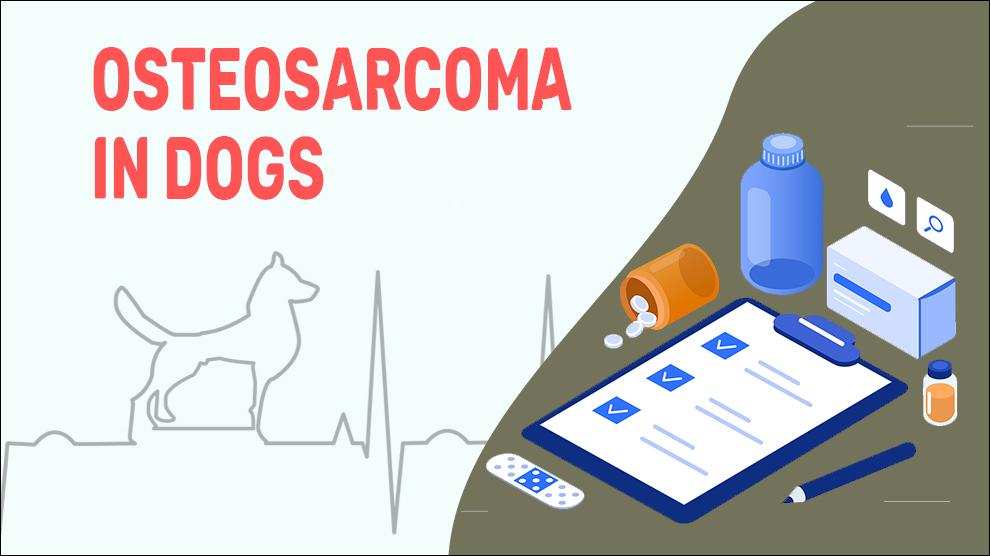Canine osteosarcoma (OSs) is malignant and highly cellular; infiltrating neoplasms in dogs especially develop from the uncontrolled proliferation in the cells that produce and break down bones (called osteoblasts and osteoclasts respectively).
Also called as also called osteogenic sarcoma (OGS), osteosarcomas are rare in dogs accounting for 15/100,000. Osteosarcomas most commonly develop in the long bones (legs and arms), though bones such as the hips, pelvis, or jaws may also be affected. Osteosarcomas affecting non-bony tissues are called extraskeletal osteosarcomas, such as the liver, spleen, kidneys, and mammary glands. Most OSs are both locally invasive and have a high likelihood to metastasize to other organs.
The most prevalent histological subtype of canine primary bone tumors both in humans and dogs is Osteosarcoma. This accounts for almost 90% of primary bone tumors. More often than not, OS is diagnosed in middle-aged to older dogs, with a median age of 8 years.
Osteosarcoma tumors are hard to categorize and it is highly heterogeneous in their manifestation. There are several subtypes according to the location within the bone, histological variation, and degree of differentiation. This malignant osseous neoplasm typically affects large and giant breed dogs; however, body size alone cannot expound the difference in incidence between different breeds of dogs. The occurrence seems to vary comprehensively between certain breeds of similar body sizes.
Symptoms Of Osteosarcoma
The osteosarcoma symptoms vary depending on the location.
- When a limb is affected (appendicular osteosarcoma): Painful, Swollen lump on long bones, Limping or appearing weak, Sudden fracture of bone from simple physical activity.
- When the liver is affected: Protruding or distended stomach, Bloating or abdominal pain, Feelings of abdominal fullness, Lethargy, Nausea, and vomiting.
- Neurologic signs, such as wobbly gait, and seizures.
Other Systemic Signs:
- Swelling / Edema of the face and extremities.
- Loss of appetite / Weight loss
- Polydipsia / Polyuria
- Breathing or digestive issues.
Treatment Options For Osteosarcoma
During diagnosis, most of the dogs will have microscopic clusters of tumor cells that already have spread to distant regions even though they were undetected by conventional tumor staging procedures (micrometastasis). Therefore, staging is always suggested in osteosarcoma treatment.
Surgical options such as amputation, radiation, chemotherapy, or a combination of these modalities may be tried.
Steroid Treatment:
(Prednisolone): 2 mg/kg (or 40 mg/m2) PO daily.
By itself, the antitumor dosage of prednisone increases average survival times to 1 to 3 months, but it is not beneficial in all cases. Sometimes, it makes subsequent chemotherapy treatment less successful.
Chemotherapy: Chemotherapy is found to be less effective. Daunorubicin, vincristine, vinblastine, dactinomycin, colchicine, etoposide, and mitoxantrone is commonly used.
Radiotherapy: This may be used to shrink cancerous cells prior to surgery or used post-op to reduce the duration of the resulting remission.
Home Remedies For Osteosarcoma
Viscum album extracts are used in the homeopathic treatment of osteosarcoma.
Recent clinical studies demonstrated that Curcumin, an active ingredient of turmeric inhibited the growth of osteosarcoma cells.
Prevention Of Osteosarcoma
Prevention is not possible for canine osteosarcoma as the causes in dogs is unidentified.
Examine your pets once a month and consult your veterinarian immediately if you find any Painful, swollen lumps on long bones, Limping, or appearing weak or distended abdomen.
Affected Breeds Of Osteosarcoma
Large Dog Breeds, Giant Dog Breeds, Great Dane, Irish Wolfhound, Boxer, Doberman Pinscher, Golden Retriever, German Shepherd, Great Pyrenees, Greyhound, Irish Setter, Labrador Retriever, Rottweiler, Saint Bernard, Weimaraner
Additional Facts For Osteosarcoma
- Causes:
- Hereditary
- Radiation or electromagnetic fields exposure or living near waste incinerators.
- Certain viral infections
- Exposure to carcinogens or toxic chemicals.
- Exposure to herbicides, pesticides, and insecticides.
- Types:
Primary Osteosarcoma: They originate in the long bones and spread to another part of the body. Primary OS has a propensity to metastasize to lymph nodes, liver, and spleen.
Secondary Osteosarcoma: That arises from a different organ or tissue and metastasizes to the bones.
- Stages:
Bone OS can be classified as:
- Stage I: Limited to the bones.
- Stage II: Fractured bones (ruptured) with or without regional lymph node involvement.
- Stage III: Metastasis to distant lymph nodes or other tissue.
- Mortality:
Stage I Tumors: With surgery alone > 2-year median survival time.
Stage II and III Tumors: With surgery alone -6 and 10 months, respectively.
- Diagnosis:
- Routine hematology, blood smears
- Physical and orthopedic examination.
- X-ray
- Computed tomography (CT) scan
- Advanced CT imaging
- Prognosis:
Osteosarcoma activity is complicated and depends on many factors. In general, the cancer is staged from 1 - 3; stage 1 is less destructive than stage 3 OS.
Most of the OS is rapidly progressive and high-grade. Initially, there will be enlarged lymph nodes and no clinical signs of illness, if left untreated, most dogs reach terminal stages 1 - 2 months from the presentation.
When To See A Vet
Contact your vet right away, if you notice any of the following:
- Painful, swollen lump on long bones.
- Limping or appearing weak.
- Swollen, nodular, firm bump, or ulcerated lumps.
Food Suggestions For Osteosarcoma
- Lean Meat Protein: White-fleshed fish, Chicken breast (skinless, boneless) turkey breasts (skinless), Beef liver, Beef (sirloin tip side steak).
- DHA: Salmon, sardines, mackerel, herring, oysters, and shrimps.
- Antioxidant-packed Fruits: Cherries, blueberries, peeled apple, cantaloupe.
- Herbs and Spices - Turmeric, Fresh ginger root, Cinnamon, Parsley, etc.
- Add calcium-rich foods and supplements such as Dark leafy greens, broccoli, salmon, Sardines, etc.
Conclusion
While the exact cause is unidentified, genetic susceptibility and environmental factors are considered to play an important role. Unfortunately, the osteosarcoma prognosis is considered to be poor. Regardless of aggressive oncological and surgical intervention, over 75% of tumors relapse within the first year.

















